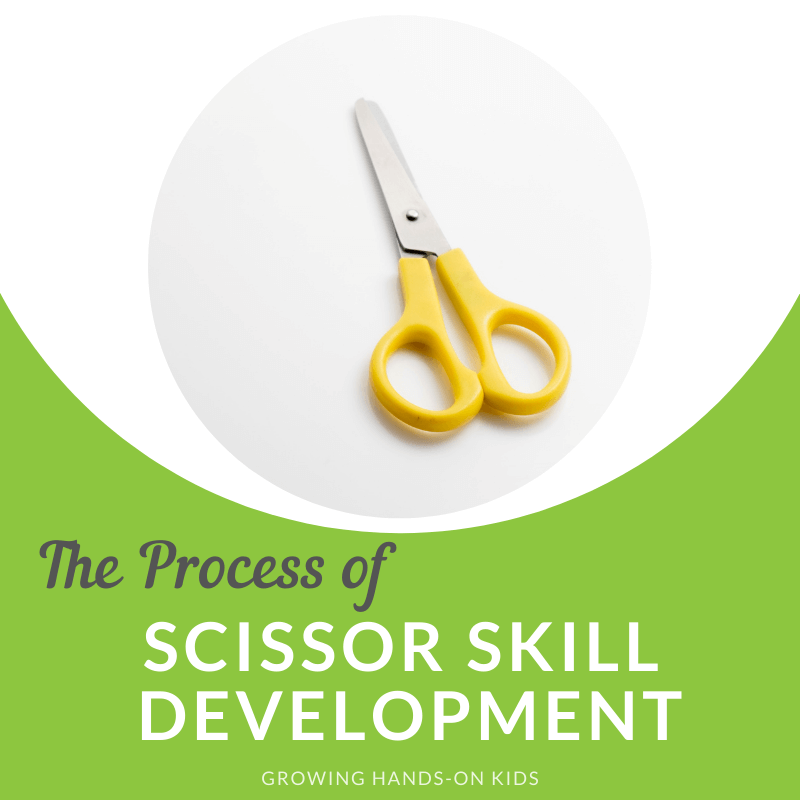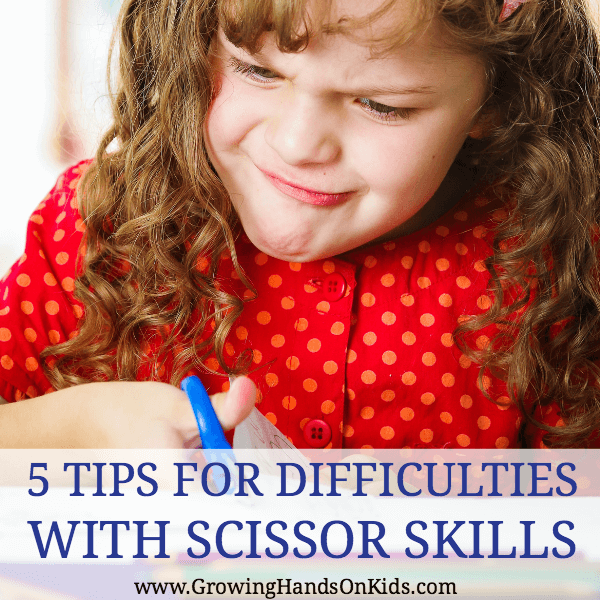The Process of Scissor Skill Development
Affiliate and Referral links are used below to promote products I love and recommend. I receive a commission on any purchases made through these links. Please see my disclosure policy for more details. As an Amazon Associate, I earn from qualifying purchases.
This blog post was contributed by The Happy Handwriter.
The truth is, I have a bit of a thing about scissor skills. I know they are important because they are a functional skill our children need to learn. They need to be able to cut out their worksheets. They need to be able to cut the pieces for their craft activities and to cut out their sight words before pasting them in place.
But there is so much more when it comes to scissor skills.
It's all about the process!
The mastery of scissors skills is about the process and not just the end product. It is great when our kids can cut their worksheets, but while they are doing that, they are opening and closing their scissors.
This grasp-release cutting motion develops the muscles of the tripod fingers for pencil grasp and pencil control while developing stability of the 4th and 5th fingers, which support the finger movements when a child writes. And this is the coolest thing ever.
Our kiddos are developing their muscles and movement patterns without even realizing it! Scissor skills are one of my number one favorites when it comes to developing these skills.
How to Help Your Child Get the Best from Scissor Skills
Choose the correct scissors. Right-handers use right-handed scissors while our lefties use left. When our kiddos use the wrong scissors for their hand preference, the positioning of the blades will obstruct the cutting line. And it is pretty challenging to cut on a line when it is hidden by something!
While it is true that a left-handed kiddo can learn to cut with right-handed scissors, it doesn't mean it is best practice. Best practice requires us to apply the professional procedures that are agreed to be most effective. And whether we know of a lefty who cuts effectively with right-handed scissors is neither here nor there. The best practice provides lefties with left-handed scissors, while right-handers use right-handed scissors
What About Ambidextrous Scissors?
Some design engineer somewhere stumbled upon the fact that molding the scissors' handles so both lefties and right-handers could use them was a real win for lefties. Only, was it? Did it actually make the scissors suitable for both right and left?
The problem with the design guy (or gal!) is that he wasn't up on scissor construction in the same way as those of us who are working with littles are.
The blades and their orientation define scissor allocation, not the comfort of the handles. The blades on the left and right-handed scissors are differently aligned. For rights, the right-hand blade is uppermost, while for lefts, the left blade is.
So while we thank the designer for his well-meaning thoughts, we know we need to seek out genuine left-handed scissors for our lefties.
Master the Grasp-Release Cutting Motion
Mastering this skill is especially important before trying to master refined control of the scissors.
All the good old OT favorites have a place here: hole punches, tweezers, handy scoopers, and the timeless spray bottle. If your kids have the grasp-release motion built in, it is one less thing for them to focus on when they have to master cutting and manipulating the paper, not to mention cutting on a line.
Thumbs Up Always!
Thumbs up is the name of the game when it comes to cutting with scissors. And this applies to both hands. This is especially evident with the assisting hand when, for reasons beyond my understanding, the pronated or palm-down hand position seems to be the default pattern our kids assume.
The same goes for the preferred cutting hand. Our kids are not going to get very far if their cutting hand is upside down. It was Jackie from Happy Hooligans who introduced the smiley face image cue that has become a winner for our preschoolers as they embark on the mastery of scissor skills.
Directional Control for Scissor Skills
Scissors not only need to cut, but they also need to be directed. Random snipping here and there is not going to be enough for scissor skills, either as a functional skill or to develop the muscle foundations we have spoken of.
There is a typical developmental sequence in which this happens. Once the grasp-release motion is in place, our kiddos need to start cutting on a line and directing their scissors to follow it.
You can pop over here and grab your scissor skill developmental download.
Pitching Scissor Skills for Developmental Abilities
We would never ask our children to run before they can walk, and we need to be clear in our minds as to the correct developmental sequence for scissor skills. When it comes to activity selection, our focus needs to be on the skill level required from the complexity of the lines our children need to cut on, not on the end product.
We can't find a great little truck that fits in with our transport theme, and decide that cutting the square for the canopy would be great as a starter before we consider the children's developmental abilities. It may simply be too difficult.
We have to be clear about where they are developmentally and pitch our activity there. Of course, we can pitch our activity just beyond their ability level to stretch their skills, but if they are busy with straight lines, a square is just too much of a leap, and they may be better off cutting strips to make the road.
Follow this directional sequence with cutting
- Straight lines
- Circles
- Eternal corners
- Internal cutouts
Scissor skills are the bomb for developing the muscle foundations for pencil grip and pencil control. Some easy-to-follow pointers will help your kids on the path to cutting success.
Grab Your Free Scissor Skills Download By Clicking Here
This blog post was contributed by The Happy Handwriter.
Get a Free Scissor Skill Development Handout
Subscribe to Growing Hands-On Kids for my weekly newsletter and get a free printable of the shape-breathing exercises.
When you subscribe to my email list, you'll also be the first to know about new printables or products I create and recommend.
If you have already subscribed to GHOK, don't worry, you aren't subscribing again. Entering your email below lets my email service provider know which printable download to send you. You will not receive duplicate emails from me in the future.
You May Also Like:

Heather Greutman, COTA
Heather Greutman is a Certified Occupational Therapy Assistant with experience in school-based OT services for preschool through high school. She uses her background to share child development tips, tools, and strategies for parents, educators, and therapists. She is the author of many ebooks including The Basics of Fine Motor Skills, and Basics of Pre-Writing Skills, and co-author of Sensory Processing Explained: A Handbook for Parents and Educators.



Hello good day,
I am a teacher for the past 23 years and I agree with your article. One thing I’ve noticed in our schools in Antigua and Barbuda, many pre- schools and Kindergarten teachers and bypassing the scissors usage and gone straight to writing. I believe that mastering scissors skills is actually setting the platform for proper writing and accurate tripod grip.